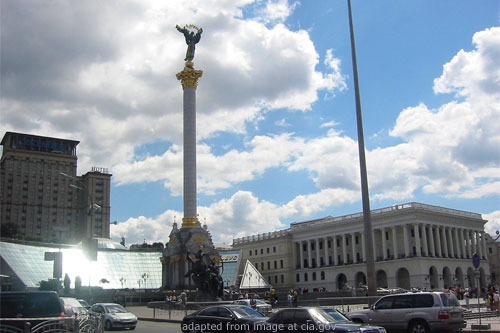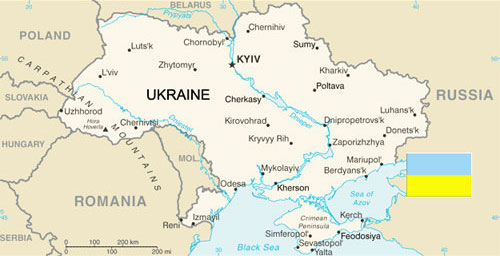Can Ukraine’s Two Nations Stay Under One Roof?

(Voice of America – James Brooke -December 14, 2013)
James Brooke is VOA Moscow bureau chief, covering Russia and the former USSR.
KYIV – To understand what is happening in Kyiv today, remember that Ukraine has a larger landmass in Europe than France, the largest nation of the European Union.
From East to West, Ukraine is longer than Italy, from the Alps to the heel of the boot.
In Northern Italy, people look to Switzerland and Germany. In Southern Italy, people look to Greece, Malta and Libya.
Similarly, Western Ukrainians look to Poland, Austria and Germany. People consider themselves European to the core. City halls in Western Ukraine now fly European Union flags. In schools, children study German and Polish. This new post-Soviet generation speaks Russian poorly, if at all.
Travel 1,200 kilometers to the East, and Ukrainians look to Russia. They produce goods that are exported to Russia. They speak Russian. The Soviet generation often has a hard time speaking Ukrainian, the national language.
For three years as President, Viktor Yanukovch has tried to balance these two sides, roughly comparable to the way pre-Civil War U.S. presidents tried to keep America’s house together by waffling on slavery.
Now, the European Union and the Kremlin are telling Ukraine: make your choice!
This winter, in the biggest political crisis since Ukraine won independence in 1991, foot soldiers for both sides are on the march.
At Kyiv’s pro-government camp, Grisha, a 30-year-old tattooed construction worker, from the Russian-speaking city of Nikolaev, says his opposition to the European Union is a no brainer. Reeling off the names of his city’s three remaining factories, all from the Soviet era, he says: “If Russia refuses to buy, the factories simply shut down.”
A few steps away, near an olive green army tent, the same fear comes from Ruslan, a fur-hatted businessman from Kremenchuk, another Eastern city.
“If we join the EU, there will be no work,” he says with conviction “All the factories will stop. Production will collapse. The EU does not need our products.”
But one kilometer down a cobblestone street, views are diametrically opposed.
In normal times, Oleg works in a pharmaceutical warehouse in Lviv, the Western Ukrainian city near Poland. But now, he mans a 3-meter high barrier that faces Kyiv’s government quarter.
Defenses start with steel cables strung across the street, move to welded metal anti-tank barriers, backed up with steel barrels. Finally, there is a high wall of sandbags filled with snow and reinforced with steel. Overhead, a banner addressed to Ukraine’s Berkut, or “Eagle” riot police reads: “Berkut, Welcome to Hell.”
Taking a break from scrutinizing a constant flow of pedestrians entering the pro-Western camp, Oleg says that entering the European Union is a no brainer.
“Look how Poland lived, and how Poland lives now,” Oleg, 45 years old, says, recalling Poland when the economy was communist and the security services answered to Moscow. “You have to go and look at the world. You can’t hide in the attic and be afraid.”
He is confident that by orienting his country toward the European Union, Ukraine can be Europe’s next Poland. He says: “The country will be more open, and investment will come, and factories will work again.”
Pressure is mounting on President Yanukovych to take make the choice for Europe.
In Kyiv, the capital, people are responding overwhelmingly in favor of the “Euromaidan.” Specialized Facebook groups channel a steady flow of warm clothing, tents, firewood and food to Kyiv’s Independence Square. Some of Ukraine’s best pop groups sing nightly on the stage. After three weeks of police attacks and freezing temperatures, the Euromaidan keeps bouncing back, always larger than before.
The Interior Ministry no longer views Kyiv police as politically reliable. Repressive actions are carried out by riot police trucked in from Russian speaking areas of Ukraine. But, in general, policemen are known to be fans of Vitaly Klitschko, the 2-meter tall boxing prize fighter who is the opposition’s rising star.
Ukraine’s Army leadership has publicly stated that the Army is politically neutral.
Ukraine’s financial oligarchs now are covering their bets.
Graphic TV coverage of the protests has moved out of the ghetto of one small commercial channel to national channels owned by wealthy Ukrainians.
Two of the nation’s richest oligarchs, Victor Pinchuk and Rinat Akhmetov, have broken their silence and called on the President to start serious talks with the opposition.
On Friday, Yanukovych’s government release all jailed protesters. On Saturday, the government fired Kyiv’s City Administrator, the City Police Chief, and a National Security Council official. At the same time, the President has mobilized his supporters, bringing tens of thousands to Kyiv by bus and train from Eastern Ukraine.
Ducking responsibility, the President blames the police violence on rogue policemen and the fact that he did not sign a EU trade and political association on his own negotiators. The policemen should be tried and the negotiators fired, the President said Friday.
On Monday, he travels to Moscow to sign economic agreements in Moscow.
Although Ukraine’s battle lines are hardening, mainstream analysts do not see secession on the horizon.
But while in the Kremlin, Ukraine’s President might want to closely inspect maps on the walls. On some maps, Ukraine’s Russian-speaking Crimea is said to be marked “Temporarily Occupied Territory.”
For three centuries, much of what is modern day Ukraine was ruled from the Kremlin. Under the Czars, it was called “Little Russia.”
In 2008, at a NATO meeting Russian President Vladimir Putin told President Bush: “Ukraine is not a real country.”
Time will tell if President Yanukovych can keep Ukraine’s two nations under one roof.

